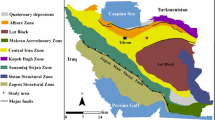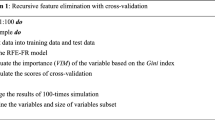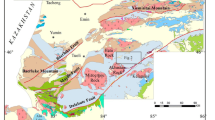Abstract
Definition of the efficient ore-forming processes, which are considered as mineralization controls is a fundamental stage in mineral prospectivity modeling. In this contribution, four efficient targeting criteria of geochemical, geological and structural data related to porphyry-type Cu deposits in Varzaghan district, NW Iran, were integrated. For creation of multi-element geochemical layer, a two-stage factor analysis was firstly conducted on ilr-transformed data of 18 selected elements and it was found that factor 1 (F1) is the representative of Cu-Au-Mo-Bi elemental association in the study area. Then, the combined model of multifractal inverse distance weighting (IDW) interpolation technique and spectrum-area (S-A) fractal method of F1 as the significant mineralization-related multi-element geochemical layer was integrated with geological-structural evidence layers. For this purpose, two supervised machine learning algorithms, namely radial basis function (RBF) neural network and support vector machine (SVM) with RBF kernel were used for generating data-driven predictive models of porphyry-Cu mineral prospectivity. Comparison of the generated models demonstrates that the former is more successful in delineating exploration targets than the latter one.













Similar content being viewed by others
References
Abbaszadeh M, Hezarkhani A, Soltani-Mohammadi S (2013) An SVM-based machine learning method for the separation of alteration zones in Sungun porphyry copper deposit. Chem Erde 73:545–554
Abedi M, Norouzi G (2012) Integration of various geophysical data with geological and geochemical data to determine additional drilling for copper exploration. J Appl Geophys 83:35–45
Abedi M, Norouzi GH, Bahroudi A (2012) Support vector machine for multi-classification of mineral prospectivity areas. Comput Geosci 46:272–283
Afzal P, Khakzad A, Moarefvand P, Omran NR, Esfandiari B, Alghalandis YF (2010) Geochemical anomaly separation by multifractal modeling in Kahang (Gor Gor) porphyry system, Central Iran. J Geochem Explor 104:34–46
Afzal P, Alghalandis YF, Khakzad A, Moarefvand P, Omran NR (2011) Delineation of mineralization zones in porphyry cu deposits by fractal concentration–volume modeling. J Geochem Explor 108:220–232
Afzal P, Harati H, Alghalandis YF, Yasrebi AB (2013) Application of spectrum–area fractal model to identify of geochemical anomalies based on soil data in Kahang porphyry-type cu deposit, Iran. Chem Erde 73:533–543
Aghazadeh M, Hou Z, Badrzadeh Z, Zhou L (2015) Temporal–spatial distribution and tectonic setting of porphyry copper deposits in Iran: constraints from zircon U–Pb and molybdenite re–Os geochronology. Ore Geol Rev 70:385–406
Agterberg FP, Bonham-Carter GF (2005) Measuring the performance of mineral-potential maps. Nat Resour Res 14:1–17
Aitchison J (1986) Coda: a microcomputer package for the statistical analysis compositional data. Chapman and Hall
Alavi M (2004) Regional stratigraphy of the Zagros fold-thrust belt of Iran and its proforeland evolution. Am J Sci 304:1–20
Behnia P (2007) Application of radial basis functional link networks to exploration for Proterozoic mineral deposits in Central Iran. Nat Resour Res 16:147–155
Berberian M, King GCP (1981) Towards a paleogeography and tectonic evolution of Iran. Can J Earth Sci 18:210–265
Bishop C, Bishop CM (1995) Neural networks for pattern recognition. Oxford university press
Bonham-Carter GF (1994) Geographic information systems for geoscientists-modeling with GIS. Computer methods in the geoscientists 13:398
Bonham-Carter GF, Agterberg FP, Wright DF (1990) Weights of evidence modelling: a new approach to mapping mineral potential. Statistical applications in the earth sciences 89:171–183
Brown WM, Gedeon TD, Groves DI, Barnes RG (2000) Artificial neural networks: a new method for mineral prospectivity mapping. Aust J Eart Sci 47:757–770
Carranza EJM (2004) Weights of evidence modeling of mineral potential: a case study using small number of prospects, Abra, Philippines. Nat Resour Res 13:173–187
Carranza EJM (2008) Geochemical anomaly and mineral prospectivity mapping in GIS (Vol. 11). Elsevier
Carranza EJM (2009) Objective selection of suitable unit cell size in data-driven modeling of mineral prospectivity. Comput Geosci 35:2032–2046
Carranza EJM (2011) Geocomputation of mineral exploration targets. Comput Geosci 37:1907–1916
Carranza EJM (2017) Natural resources research publications on geochemical anomaly and mineral potential mapping, and introduction to the special issue of papers in these fields. Nat Resour Res 26:379–410
Carranza EJM, Hale M (2002) Where are porphyry copper deposits spatially localized? A case study in Benguet province, Philippines. Nat Resour Res 11:45–59
Carranza EJM, Laborte AG (2015a) Data-driven predictive mapping of gold prospectivity, Baguio district, Philippines: application of random forests algorithm. Ore Geol Rev 71:777–787
Carranza EJM, Laborte AG (2015b) Random forest predictive modeling of mineral prospectivity with small number of prospects and data with missing values in Abra (Philippines). Comput Geosci 74:60–70
Carranza EJM, Laborte AG (2016) Data-driven predictive modeling of mineral prospectivity using random forests: a case study in Catanduanes Island (Philippines). Nat Resour Res 25:35–50
Carranza EJM, Hale M, Faassen C (2008) Selection of coherent deposit-type locations and their application in data-driven mineral prospectivity mapping. Ore Geol Rev 33:536–558
Chen C, He B, Zeng Z (2014) A method for mineral prospectivity mapping integrating C4. 5 decision tree, weights-of-evidence and m-branch smoothing techniques: a case study in the eastern Kunlun Mountains, China. Earth Sci Inf 7:13–24
Cheng Q (1999) Spatial and scaling modelling for geochemical anomaly separation. J Geochem Explor 65:175–194
Cheng Q (2000) Interpolation by means of multiftractal, kriging and moving average techniques. In GAC/MAC meeting of GeoCanada2000, Calgary
Cheng Q (2007) Mapping singularities with stream sediment geochemical data for prediction of undiscovered mineral deposits in Gejiu, Yunnan Province, China. Ore Geol Rev 32:314–324
Cheng Q, Agterberg FP, Ballantyne SB (1994) The separation of geochemical anomalies from background by fractal methods. J Geochem Explor 51:109–130
Cheng Q, Xu Y, Grunsky E (1999) Integrated spatial and spectral analysis for geochemical anomaly separation. In: Lippard, S.J., Naess, A., Sinding-Larsen, R. (Eds.), Proceedings of the fifth annual conference of the International Association for Mathematica Geology, Trondheim, Norway 6 e11th august. 11, pp. 87e92
Cheng Q, Xu Y, Grunsky E (2000) Integrated spatial and spectrum method for geochemical anomaly separation. Nat Resour Res 9:43–52
Cheng Q, Xia Q, Li W, Zhang S, Chen Z, Zuo R, Wang W (2010) Density/area power-law models for separating multi-scale anomalies of ore and toxic elements in stream sediments in Gejiu mineral district, Yunnan Province, China. Biogeosciences 7:3019–3025
Cooke DR, Hollings P, Walshe JL (2005) Giant porphyry deposits: characteristics, distribution, and tectonic controls. Econ Geol 100:801–818
Cox DP, Singer DA (1986) Mineral deposit models (Vol. 1693). Bulletin. US Government Printing Office
Cox SF, Etheridge MA, Wall VJ (1987) The role of fluids in syntectonic mass transport, and the localization of metamorphic vein-type ore deposits. Ore Geol Rev 2:65–86
De Palomera PA, van Ruitenbeek FJ, Carranza EJM (2015) Prospectivity for epithermal gold–silver deposits in the Deseado Massif, Argentina. Ore Geol Rev 71:484–501
Dilek Y, Imamverdiyev N, Altunkaynak Ş (2010) Geochemistry and tectonics of Cenozoic volcanism in the lesser Caucasus (Azerbaijan) and the peri-Arabian region: collision-induced mantle dynamics and its magmatic fingerprint. Int Geol Rev 52:536–578
Egozcue JJ, Pawlowsky-Glahn V, Mateu-Figueras G, Barcelo-Vidal C (2003) Isometric logratio transformations for compositional data analysis. Math Geol 35:279–300
Geranian H, Tabatabaei SH, Asadi HH, Carranza EJM (2016) Application of discriminant analysis and support vector machine in mapping gold potential areas for further drilling in the sari-Gunay gold deposit, NW Iran. Nat Resour Res 25:145–159
Ghezelbash R, Maghsoudi A (2018a) A hybrid AHP-VIKOR approach for prospectivity modeling of porphyry cu deposits in the Varzaghan District, NW Iran. Arab J Geosci 11:275
Ghezelbash R, Maghsoudi A (2018b) Comparison of U-spatial statistics and C–A fractal models for delineating anomaly patterns of porphyry-type Cu geochemical signatures in the Varzaghan district, NW Iran. C R Geosci 350:180–191
Ghezelbash R, Maghsoudi A, Daviran M (2018a) Prospectivity modeling of porphyry copper deposits: recognition of efficient mono-and multi-element geochemical signatures in the Varzaghan district, NW Iran. Acta Geochim 1–14
Ghezelbash R, Maghsoudi A, Carranza EJM (2018b) An improved data-driven multiple criteria decision-making procedure for spatial modeling of mineral prospectivity: adaptation of prediction-area plot and logistic functions. Nat Resour Res. https://doi.org/10.1007/s11053-018-9448-6
Hariharan S, Tirodkar S, Porwal A, Bhattacharya A, Joly A (2017) Random forest-based prospectivity modelling of greenfield terrains using sparse deposit data: an example from the Tanami region, western Australia. Nat Resour Res 26:489–507
Harris D, Zurcher L, Stanley M, Marlow J, Pan G (2003) A comparative analysis of favorability mappings by weights of evidence, probabilistic neural networks, discriminant analysis, and logistic regression. Nat Resour Res 12:241–255
Hezarkhani A (2006) Petrology of the intrusive rocks within the Sungun porphyry copper deposit, Azerbaijan, Iran. J Asian Earth Sci 27:326–340
Hezarkhani A, Williams-Jones AE (1998) Controls of alteration and mineralization in the Sungun porphyry copper deposit, Iran; evidence from fluid inclusions and stable isotopes. Econ Geol 93:651–670
Hu S, Cheng Q, Wang L, Xu D (2013) Modeling land price distribution using multifractal IDW interpolation and fractal filtering method. Landsc Urban Plan 110:25–35
Huang C, Davis LS, Townshend JRG (2002) An assessment of support vector machines for land cover classification. Int J Remote Sens 23:725–749
Jamali H, Dilek Y, Daliran F, Yaghubpur A, Mehrabi B (2010) Metallogeny and tectonic evolution of the Cenozoic Ahar–Arasbaran volcanic belt, northern Iran. Int Geol Rev 52:608–630
Kavzoğlu T, Çölkesen I (2009) A kernel functions analysis for support vector machines for land cover classification. Int J Appl Earth Obs 11:352–359
Kreuzer OP, Blenkinsop TG, Morrison RJ, Peters SG (2007) Ore controls in the charters towers goldfield, NE Australia: constraints from geological, geophysical and numerical analyses. Ore Geol Rev 32:37–80
Lima A, De Vivo B, Cicchella D, Cortini M, Albanese S (2003) Multifractal IDW interpolation and fractal filtering method in environmental studies: an application on regional stream sediments of (Italy), Campania region. Appl Geochem 18:1853–1865
Lindsay M, Aitken A, Ford A, Dentith M, Hollis J, Tyler I (2016) Reducing subjectivity in multi-commodity mineral prospectivity analyses: modelling the West Kimberley, Australia. Ore Geol Rev 76:395–413
Lisitsin V (2015) Spatial data analysis of mineral deposit point patterns: applications to exploration targeting. Ore Geol Rev 71:861–881
Maghsoudi A, Yazdi M, Mehrpartou M, Vosoughi M, Younesi S (2014) Porphyry Cu–Au mineralization in the Mirkuh Ali Mirza magmatic complex, NW Iran. J Asian Earth Sci 79:932–941
McKay G, Harris JR (2016) Comparison of the data-driven random forests model and a knowledge-driven method for mineral prospectivity mapping: a case study for gold deposits around the Huritz group and Nueltin suite, Nunavut, Canada. Nat Resour Res 25:125–143
Mehrpartou M (1993) Geological map of Varzaghan, scale 1: 1,000,000. Geological survey of Iran
Meshkani SA, Mehrabi B, Yaghubpur A, Sadeghi M (2013) Recognition of the regional lineaments of Iran: using geospatial data and their implications for exploration of metallic ore deposits. Ore Geol Rev 55:48–63
Moon WM (1990) Integration of geophysical and geological data using evidential belief function. IEEE Trans Geosci Remote Sens 28:711–720
Niros AD, Tsekouras GE (2012) A novel training algorithm for RBF neural network using a hybrid fuzzy clustering approach. Fuzzy Sets Syst 193:62–84
Nykänen V (2008) Radial basis functional link nets used as a prospectivity mapping tool for orogenic gold deposits within the Central Lapland Greenstone Belt, Northern Fennoscandian shield. Nat Resour Res 17:29–48
Parsa M, Maghsoudi A, Yousefi M, Sadeghi M (2016a) Recognition of significant multi-element geochemical signatures of porphyry Cu deposits in Noghdouz area, NW Iran. J Geochem Explor 165:111–124
Parsa M, Maghsoudi A, Ghezelbash R (2016b) Decomposition of anomaly patterns of multi-element geochemical signatures in Ahar area, NW Iran: a comparison of U-spatial statistics and fractal models. Arab J Geosci 9:260
Parsa M, Maghsoudi A, Yousefi M, Sadeghi M (2016c) Prospectivity modeling of porphyry-Cu deposits by identification and integration of efficient mono-elemental geochemical signatures. J Afr Earth Sci 114:228–241
Parsa M, Maghsoudi A, Yousefi M, Carranza EJM (2017a) Multifractal interpolation and spectrum–area fractal modeling of stream sediment geochemical data: implications for mapping exploration targets. J Afr Earth Sci 128:5–15
Parsa M, Maghsoudi A, Yousefi M (2017b) An improved data-driven fuzzy mineral prospectivity mapping procedure; cosine amplitude-based similarity approach to delineate exploration targets. Int J Appl Earth Obs 58:157–167
Parsa M, Maghsoudi A, Yousefi M (2018) Spatial analyses of exploration evidence data to model skarn-type copper prospectivity in the Varzaghan district, NW Iran. Ore Geol Rev 92:97–112
Pirajno F (2010) Intracontinental strike-slip faults, associated magmatism, mineral systems and mantle dynamics: examples from NW China and Altay-Sayan (Siberia). J Geodyn 50:325–346
Porwal A, Carranza EJM, Hale M (2003) Knowledge-driven and data-driven fuzzy models for predictive mineral potential mapping. Nat Resour Res 12:1–25
Reddy RKT, Bonham-Carter GF (1991) A decision-tree approach to mineral potential mapping in snow Lake area, Manitoba. Can J Remote Sens 17:191–200
Reimann C, Filzmoser P, Garrett RG (2002) Factor analysis applied to regional geochemical data: problems and possibilities. Appl Geochem 17:185–206
Rodriguez-Galiano VF, Chica-Olmo M, Chica-Rivas M (2014) Predictive modelling of gold potential with the integration of multisource information based on random forest: a case study on the Rodalquilar area, Southern Spain. Int J Geogr Inf Sci 28:1336–1354
Rodriguez-Galiano V, Sanchez-Castillo M, Chica-Olmo M, Chica-Rivas M (2015) Machine learning predictive models for mineral prospectivity: an evaluation of neural networks, random forest, regression trees and support vector machines. Ore Geol Rev 71:804–818
Sibson RH (1996) Structural permeability of fluid-driven fault-fracture meshes. J Struct Geol 18:1031–1042
Sillitoe RH (2010) Porphyry copper systems. Econ Geol 105:3–41
Skabar AA (2005) Mapping mineralization probabilities using multilayer perceptrons. Nat Resour Res 14:109–123
Spadoni M, Voltaggio M, Cavarretta G (2005) Recognition of areas of anomalous concentration of potentially hazardous elements by means of a subcatchment-based discriminant analysis of stream sediments. J Geochem Explor 87:83–91
Tessema A (2017) Mineral systems analysis and artificial neural network modeling of chromite prospectivity in the Western limb of the bushveld complex, South Africa. Nat Resour Res 26:465–488
Vapnik V (1995) Nature of statistical learning theory. John Wiley and Sons, Inc., New York
Wang J, Zuo R (2015) A MATLAB-based program for processing geochemical data using fractal/multifractal modeling. Earth Sci Inf 8:937–947
Xiao F, Chen J, Zhang Z, Wang C, Wu G, Agterberg FP (2012) Singularity mapping and spatially weighted principal component analysis to identify geochemical anomalies associated with ag and Pb-Zn polymetallic mineralization in Northwest Zhejiang, China. J Geochem Explor 122:90–100
Xie S, Cheng Q, Xing X, Bao Z, Chen Z (2010) Geochemical multifractal distribution patterns in sediments from ordered streams. Geoderma 160:36–46
Yousefi M, Carranza EJM (2015) Prediction–area (P–A) plot and C–A fractal analysis to classify and evaluate evidential maps for mineral prospectivity modeling. Comput Geosci 79:69–81
Yousefi M, Kamkar-Rouhani A, Carranza EJM (2012) Geochemical mineralization probability index (GMPI): a new approach to generate enhanced stream sediment geochemical evidential map for increasing probability of success in mineral potential mapping. J Geochem Explor 115:24–35
Yousefi M, Kamkar-Rouhani A, Carranza EJM (2013) Application of staged factor analysis and logistic function to create a fuzzy stream sediment geochemical evidence layer for mineral prospectivity mapping. Geochem Explor Env Analysis:2012–2144
Yuan F, Li X, Zhou T, Deng Y, Zhang D, Xu C, Jowitt SM (2015) Multifractal modelling-based mapping and identification of geochemical anomalies associated with Cu and Au mineralisation in the NW Junggar area of northern Xinjiang Province, China. J Geochem Explor 154:252–264
Zarasvandi A, Rezaei M, Sadeghi M, Lentz D, Adelpour M, Pourkaseb H (2015) Rare earth element signatures of economic and sub-economic porphyry copper systems in Urumieh–Dokhtar magmatic arc (UDMA), Iran. Ore Geol Rev 70:407–423
Zuo R (2011) Identifying geochemical anomalies associated with Cu and Pb–Zn skarn mineralization using principal component analysis and spectrum–area fractal modeling in the Gangdese Belt, Tibet (China). J Geochem Explor 111:13–22
Zuo R, Carranza EJM (2011) Support vector machine: a tool for mapping mineral prospectivity. Comput Geosci 37:1967–1975
Zuo R, Wang J (2016) Fractal/multifractal modeling of geochemical data: a review. J Geochem Explor 164:33–41
Zuo R, Cheng Q, Agterberg FP, Xia Q (2009) Application of singularity mapping technique to identify local anomalies using stream sediment geochemical data, a case study from Gangdese, Tibet, western China. J Geochem Explor 101:225–235
Zuo R, Xia Q, Wang H (2013) Compositional data analysis in the study of integrated geochemical anomalies associated with mineralization. Appl Geochem 28:202–211
Acknowledgements
The authors would like to thank Prof. H. A. Babaie, Editor-in-Chief, and two anonymous reviewers for their constructive comments and edits.
Author information
Authors and Affiliations
Corresponding author
Additional information
Communicated by: H. Babaie
Publisher’s Note
Springer Nature remains neutral with regard to jurisdictional claims in published maps and institutional affiliations.
Rights and permissions
About this article
Cite this article
Ghezelbash, R., Maghsoudi, A. & Carranza, E.J.M. Performance evaluation of RBF- and SVM-based machine learning algorithms for predictive mineral prospectivity modeling: integration of S-A multifractal model and mineralization controls. Earth Sci Inform 12, 277–293 (2019). https://doi.org/10.1007/s12145-018-00377-6
Received:
Accepted:
Published:
Issue Date:
DOI: https://doi.org/10.1007/s12145-018-00377-6




